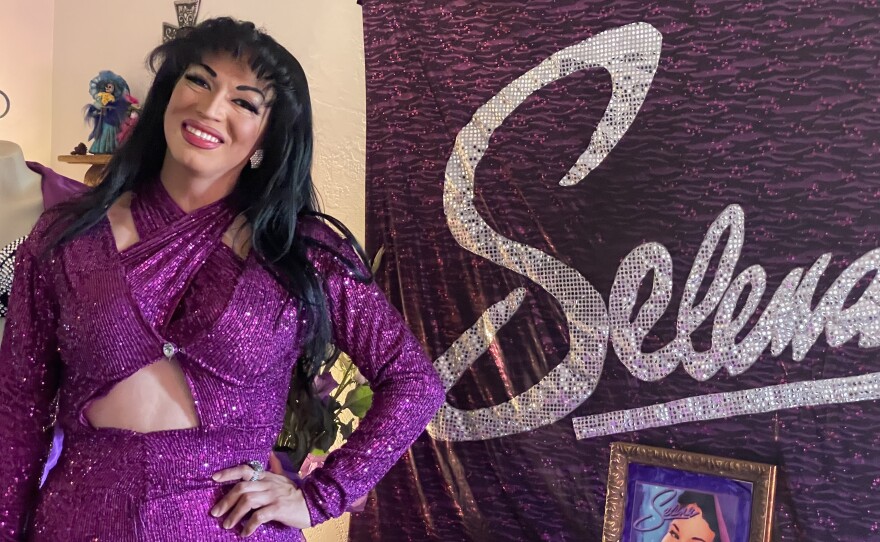Legendary Tejano singer Selena Quintanilla Perez died 27 years ago. Her devoted fans across the world remembered her passing recently on March 31.
One of those many fans is San Diego Selena impersonator, Georgette. Born Jorge Noe Ledezma in a small town just north of Mexico City, Georgette sat at her kitchen table with a powder puff and makeup recently, preparing to become her alter ego.
“I had a lot of bullying when I was a kid because of who I am, but I love what I do. That’s the main thing, “ she said.
Selena died tragically in 1995 after being shot by the president of her fan club, Yolanda Saldivar, in Corpus Christi, Texas.
The death devastated Georgette but ultimately helped her find her true identity.
Georgette immigrated to San Diego more than 20 years ago. Signs of Selena are everywhere in her life, including mementos and memories of visiting her grave site in South Texas. All of it has brought happiness and confidence she credited to Selena, her songs, and her spirit.
“She didn’t speak Spanish so well when she was interviewed. But always you can see she was giving her best. This is my first time having an interview in English, and I’m trying to give my best. So, we have something in common with that, “ she said.
The sounds of Selena are now part of the curriculum at San Diego State University.

Professor Nathian Shae Rodriguez pitched the idea for a Selena class to the SDSU administration before the COVID-19 pandemic.
It took a couple of years of convincing and development, but the Selena class is now a permanent elective offered in the spring semester. The class is meeting this year in person for the first time.
Dr. Nate, as students call him, is a fan and fellow Texan by way of San Antonio and Odessa. He grew up with a heavy influence from the Tejano singer. The class syllabus includes 16-weeks of learning modules that use Selena as a bridge to Latino culture, media representation and personal identity.

There are field trips for students, too. “They got to go out into Barrio Logan. They got to see the Selena Mercado and walk the block,” Rodriguez said. “They get to go to Mujeres Brew House for the release of the Selena beer. They get to go see drag shows to conduct an ethnography and write about it.”
An ethnography is the study of people in their own environment. Currently, students are focused on learning of the singer’s impact on the LGBTQ community.
“Selena is a huge inspiration to the queer community,” Rodriguez continued, “tons of drag queens will impersonate her. A lot of queer people, such as myself, find meaning in her music. We will learn how we can queer not just Selena’s music but the Latinx culture.”
The term "pocha" is an important vocabulary word often talked about in class discussions. A "pocha/o" is a Latino slang for a person caught between two cultures. They are not completely able to speak Spanish and not completely comfortable in the English-speaking culture. It’s a term often applied to the late Selena.
SDSU senior Karina Bazarte can relate. She said her Mexican parents thought they helped her by taking her from the barrio and enrolling her in schools with mostly white students.
“The most predominantly white schools and I couldn’t find myself. I thought, am I the only one who looks different?,” Bazarte said. “Am I the only one that doesn’t have blonde hair and blue eyes? Selena helped me identify who I am now.”
Paul Aguirre is inspired by Selena’s brother A.B., who continued making music after her death.
“Him being a music producer and Mexican-American gave me an outlet,” Aguirre said. “He gave me a platform and inspired me that I can make it as well.”
Nathalia Martinez was only 3 weeks old when Selena was killed. “I never really got to have her present, but I had her music," she said. "That’s where I was able to create Selena in my head and thought how this is someone I can have as my role model.”

Which brings us back to Georgette and the little boy from a little Mexican town who used to dance around his living room imagining what he could become someday.
“I think the thing I learned from her is to always be respectful and to be kind and sweet,” she said, “that’s how I remember her and what I do every time I’m on stage.”
That’s a legacy set to music that will never die.






